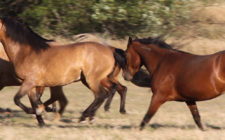
Nearly every culture on Earth has a close connection with horses. European cave paintings show that we’ve related to them and relied on them for tens of thousands of years.
Over the ages we humans developed types of horses that reflected our particular environment, needs, and way of life. Thus each horse breed reflects the character and personality of the culture that developed it.

We depend on horses, mules, and donkeys for travel and transport, outdoor work of all kinds, for service in war, as artistic inspiration and in some cultures, as a food source. They share in our joys and sorrows of life during recreation and sport, as well as in the celebration of life passages such as weddings and funerals. We imagine taking on their beauty, nobility, and power in our stories and ancient myths.
Horses are teachers and therapists both in our backyards and stables, and in the growing fields of equine facilitated physical and emotional therapy, life and business coaching. We recognize them for their generosity and willingness, as well as for their ability to offer training in mindfulness, or awareness.
The size and intensity of the electromagnetic field emanating from a horse’s heart can be measured now; it is far larger than ours. Electronic displays show us how the horse’s electromagnetic field and ours can become coherent, or the same in size and frequency of electromagnetic wave output. We also can measure how horses’ brain waves and ours become synchronized when we are working or simply standing together.

Horses and humans are not biological machines but sentient beings with a high level of consciousness, possessing self-awareness, emotional expression, communication skills, and healing ability as well as a connection to spirit. Our twenty-first century machines are showing us what we have always known in our hearts: horses literally and spiritually carry us forward on our journey and can inspire community- and heart-based living in harmony with nature.

